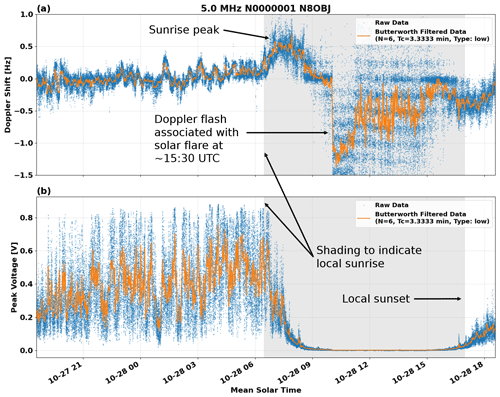GRAPE Science
The Science Behind the GRAPE HF Receiver/Doppler Monitor
The following is an abbreviated summary of the science behind the GRAPE receiver network and how the GRAPE creates valuable data for scientific study. It is recommended that the reader follow the links at the end of this page to gain a full understanding of the concepts described here. Before diving in, it would be helpful to understand Doppler effect, and also to be aware of the HamSCI Glossary.
(Why is it called a GRAPE? It's an acronym: Great Radio Amateur Propagation Experiment. Also, because GRAPES do their best work in 'bunches' {the bigger the network, the more data collected}.)
Scientific Interests
The GRAPE, one module in the HamSCI Personal Space Weather Station (PSWS) network, has proven to be useful in the study of short-term (lasting hours to days) geophysical and solar events, such as traveling ionospheric disturbances, solar flares, solar eclipses and geomagnetic storms. It does so by observing the bottom side of the ionosphere. Data from PSWS member stations, often combined with observations from other scientific instruments, yields clues as to how and why those events impact HF (high-frequency, 3–30 MHz) radio wave propagation. The data can also be used to improve mathematical models of the ionosphere, which should result in more accurate predictions of HF propagation (such as maps of the MUF and critical frequencies).
Role of the GRAPE in the HamSCI PSWS Project
HF Doppler sounding is an established means of observing the bottom side of the ionosphere. Its principle of operation is straightforward: A shift in signal path length causes a corresponding Doppler shift (Figure 1). The Grape receiver performs Doppler measurements by measuring the carrier freqency of frequency standard stations such as WWV/H (or CHU). Their transmit frequency accuracy and stability is less than one part in 10^13 - an incredibly small value. Measurements of the WWV/H frequency at a distant receiver site is limited by a few factors, one of which is the receiver’s accuracy and stability, the other is the propagation path. The former is well accounted for in the design of the GRAPE, the latter is the primary measurement of interest. In other words, those who study the GRAPE measurements are not overly concerned about the absolute value of the receive frequency, but they are extremely interested in the variation of the received frequency over time (typical GRAPE datasets are broken into 24 hour periods) (Figure 2).

Figure 1: A simplified illustration of the relationship between rate of change in ionospheric layer height and received frequency shift. Precision frequency standards are required at both beacon and receiver in order to make an effective comparison. Frequency variation is generally on the order of ±1 Hz. Multihop propagation (multiple reflections between ionosphere and ground), Pedersen modes (internal ionospheric reflections), asymmetric paths, and other factors impacting path length are not shown. Reproduced from Collins et al. (2022).

Figure 2: Annotated frequency and amplitude plots of Node 1's 5 MHz data from 28 October 2021, with sunrise and sunset indicated by background shading. The filtered result is superimposed on the raw data. The day's sunrise peak is clearly visible. The horizontal axis is plotted in mean solar time, rather than UTC, in order to emphasize the effects of the 24-hour day/night cycle. A Doppler flash associated with an X-class solar flare is evident around 15:30 UTC. Reproduced from Collins et al. (2022).
Viewing GRAPE Data
GRAPE data can be in one of two formats: fldigi CSV or DRF (Digital Radio Format).
- The fldigi data (from Grape 1, fldigi version, and Grape 2s) can be found on Zenodo. It is the official FAIR repository for data collected for fldigi Grapes. It is manually updated every few months (2019 to present).
- Grape 1-DRF and WSPR Daemon GRAPE receiver data can be found on the Personal Space Weather Station Central Control System (self-created user account required). Uploads occur daily (2021 to present).
Further Information
For further information, please review these papers, presentations and posters. More on this subject can be found in the Publications on this site.
- PSWS Overview
- Grape Personal Space Weather Station Doppler Observations (peer reviewed paper)
- The potential of HamSCI Doppler Observations for inferring Solar Flare Effects on the Ionosphere (conference proceeding)
- HF Doppler Observations of Traveling Ionospheric Disturbances in a WWV Signal Received with a Network of Low Cost HamSCI Personal Space Weather Stations (poster and explanatory video)
